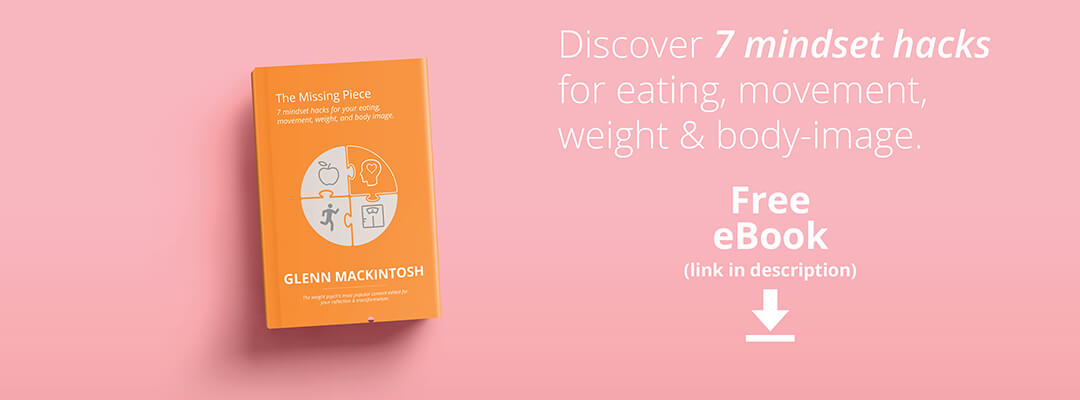
In this Thursday Therapy episode, Glenn Mackintosh helps you understand why it is harmful to forbid foods, and shows you how to eat less of the foods that aren’t very nutritious for you without creating rigid rules!
Watch Video
I created this video for people just like you.
If you found it valuable, please help me share it with them!
LINKS FROM VIDEO
Glenn’s Blog on the 5 Principles of Mindful Eating: http://bit.ly/21gwhRP
SHOW NOTES
- Viewer question about reducing less nutritious foods without creating rigid rules. [01:27]
- The psychological rebellion that happens when we “forbid” certain foods. [01:58]
- The “forbidden fruit” effect. [02:27]
- The “what the hell” effect. [02:42]
- Food being morally neutral. [03:35]
- Principle: allowing all foods. [04:41]
- Food-body congruence – eating foods your body likes. [05:38]
- Freud pleasure principle and how it applies to mindful eating. [07:14]
- Creating “food-body congruence” develops an internal motivator to eat well. [07:24]
TRANSCRIPT
Hey everyone, welcome to Thursday Therapy. I’m Glenn Mackintosh, the weight psych, and I’m really enjoying delivering these Thursday Therapies to you every couple of weeks. A few people are writing into me and I love your feedback.
So, thank you for all of the positive feedback saying; “Looking forward to next Thursday and you’ll have to look forward, not to next Thursday, but the one after because we’re doing Thursday Therapy every two weeks. Guys, I have a bunch of face-to-face clients and most of them I don’t even see every week, I see them every two or three weeks. So, a couple of weeks is perfect timing for you to play around with the ideas, experiment with them and find the way that they work for you.
A question today is a really good one, follows up from our last Thursday Therapy and the question is about if we don’t ban foods and we don’t forbid foods, how do we actually end up eating healthier and managing those foods that might not be so good for us. Brilliant question that a lot of my clients have, so let’s get the answering it. Susan asks “A follow-up to last week, especially regarding forbidden foods. What about if it actually helps to reduce the foods – for example, wheat and grain?” Susan had read a book on wheat and a book on grain and found that since following that information, she said “I have less brain fog and have lost weight” interested in your thoughts, Susan.”
Great question Susan. Before I answer it though, I do want to clear up why we don’t forbid certain foods. When we label certain foods is bad or wrong and tell ourselves we can’t have them, we start this whole range of psychologically rebellious processes that actually get us ending up eating more rather than less. I want to talk you through a couple of them just so you get the idea of what can happen in your brain when we say no to certain foods and when we label those foods as bad. Firstly, we get what we call “the forbidden fruit effect”. You probably know what this is there is a rebellious teenager inside every one of us and when someone says, “You can’t have that”, we want more of it. So, we don’t want to do that with food. The other effect that’s really common when you ban certain foods is what we call, “The what the hell effect”. This effect you might understand, as well a lot of people do this, it’s where you’re going on with your eating plan, eating all the good and allowed foods and then something happens whatever that is and you eat one of the “bad foods”.
Typically what happens with a lot of people is you feel like you’ve done something wrong, you feel quite guilty and then you think, “Oh look, my plans over I’ll just start again tomorrow or I’ll start again next Monday or I’ll start again never”, and you just have it open the floodgates and it’s real party time so the what the hell effect and the forbidden fruit effect are just two of the many psychologically rebellious processes that happen when we say no to certain foods and when we give those foods that moral label. In fact, I’d like to introduce to you this idea that food is morally neutral; t’s not good, it’s not bad, it’s not right, it’s not wrong, it’s just off the scale for moral judgement. Most psychologists, me included, think that we judge ourselves and other people too often but I think if you do need some criteria to judge yourself, surely you can choose something better than what you put in your mouth. So, let’s start to learn to think of food as morally neutral.
That said, you know and I know that certain foods are not great for us. Sometimes if we eat too much of a certain food or we eat it too regularly or even if we have allergies or intolerances for that food, even if we eat it in small amount, it’s not great for us. So, how do we balance out these two things? Well the answer, and we’re going to keep coming back to this in Thursday Therapies, is in mindful or intuitive eating. The first principle of mindful eating, we’ve actually been talking about this whole session, is allowing foods. So, we can’t do mindful intuitive eating and not allow certain foods. If we’re restricting foods we’re not doing intuitive eating.
So, we’ve already covered that and in Thursday Therapy episode two we talked through another couple of the principles of mindful eating. Those principles were; listening to your hunger and fullness and being present and mindful when you eat. So, if you want to review that video you can, in fact, what I’ll do is, I’ll provide a link below to a blog that I have that talks you through the whole five principles of mindful eating, so you can really start to get a grasp on these principles that will help you to eat naturally without even trying.
Now, the last of those principles you’re going to find is, and this is the one we’re going to talk about now, food-body congruence. So, what this means is eating foods that your body likes. Now, Susan actually alluded to this a little bit when she talked about in less wheat and less grain that she had less brain fog. So, she didn’t have necessarily a ruling in her mind and in fact she was allowing foods. She said here, “I can still eat some sugary desserts, “bad food”, haha, but I don’t automatically get sucked into that out-of-control cycle.” So, what that says to me is that she’s actually got that first principle right, she’s taken the information that grains and wheat may not be so great for her body but she hasn’t created a rule around that she can’t eat them.
So, she’s got that first part right and that’s actually allowed her to have this food-body congruence to start to realize that when she eats less of these foods she has less brain fog. So, that’s what food-body congruence is; just noticing how different foods effect your body. Now, if you’ve got judgments around those foods being bad, it’s very hard, in fact probably impossible, to tell how they affect you. Because every time you eat a food that you label as bad, you end up feeling guilty, shameful and hopeless, it’s very hard for you to tell how the actual food is affecting your body.
But when we take off that moral judgment, what you’re going to find is you can start to develop a real intuition as to how these foods make you feel. And our grandfather of psychology got it right, Freud. He said that you know everything human beings do is towards pleasure and away from pain and if you without the moral judgment can start to notice that better nutritional foods help you feel better and the less nutritional foods, especially if you eat them regularly or in big amounts, don’t make you feel so great, you develop a real intuition and a real want to eat well because eating well makes you feel good. It’s not rules-based, it’s not weight loss based, it’s a very powerful internal motivation and you’ll just find that you naturally want to eat well without even trying. This is probably something you want, this is something a lot of my clients tell me that they want, it doesn’t happen overnight because you need to really continually pair those eating experiences with how you feel and just pay attention and check in with how you’re feeling, but you will find that over time you do develop this natural intuition that you just naturally, without even trying, you want to eat more of the nutritious stuff, you don’t want to eat as much of the less nutritious stuff. And that is how you find the balance without creating food rules to eat really, really healthily. I hope that answers your question. Thank You, Susan for a great question.
I’m really looking forward to seeing you at the next Thursday Therapy. Thank you for all the questions. I will say guys, if you’ve got really long questions please shorten them up, so it’s something that I can easily refer to your question in the video, but apart from that keep the questions coming, and I’ll look forward to seeing you at the next Thursday Therapy.





